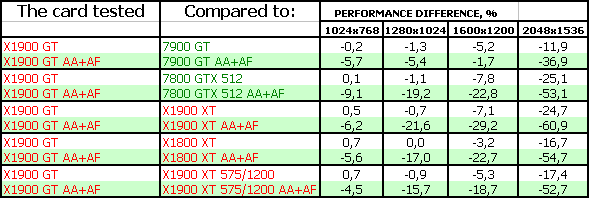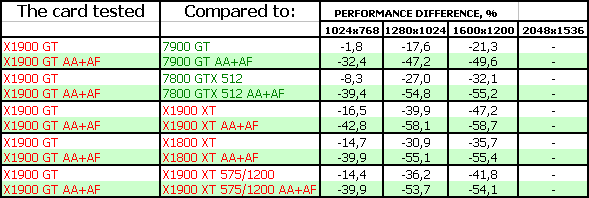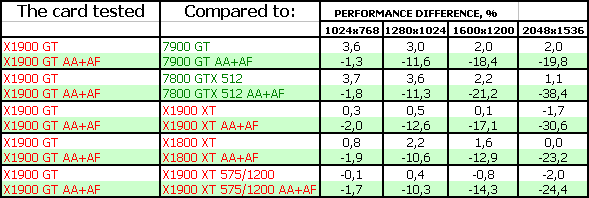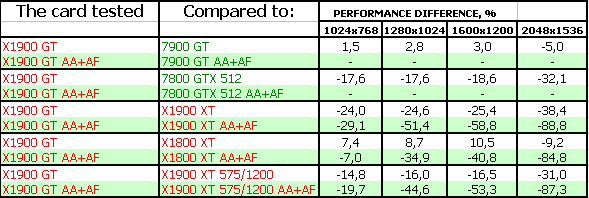 |
||
|
||
| ||
TABLE OF CONTENTSRumours about defeatured R580 modifications to appear even before ATI would launch new Middle-End solutions have been circulating for quite a long time already. And now it has happened. It's well known that the Canadian company had a gap in the $300 sector of modern accelerators supporting all 3D innovations. All the previous products as well as the curtailed R520 (X1800 GTO) are designed for cheaper segments. And the Hi-End X1900 has not gone down below $450 yet. Taking into account that NVIDIA products cover all price segments, the situation of the Canadians is hardly enviable. And here appears RADEON X1900 GT. Like the X1800 GTO, it's also a defeatured product, not only in core, but also in memory size - we haven't seen X1900 XT/XTX 256MB cards so far. And the X1900 GT is equipped with this much memory. The core is cut down by 1/4: there are only 12 units instead of 16 ROPs and texture units. And there are only 36 pixel units instead of 48. Besides, its operating frequencies are reduced from 625/1450 MHz (X1900 XT) to 575/1200 MHz (X1900 GT). So, the reasons for launching this product are clear. Moreover, we have heard that thanks to very good yield of effective chips, the company uses sterling R580 chips for X1900 GT cards - it just locks them. There is no way to unlock the chips, of course. This method was successfully tested a year and a half ago: if ATI forbids unlocking - you cannot do it, no matter how hard you try. Production volume of such cards is limited, as they use sterling but locked cores. So the company needs to produce as many cards as necessary to hang on until the launch of RV570 - a middle-end product to take up this niche later. So we have information that the company will produce only 25,000 X1900 GT cards. Thus, there may be shortage of these cards. And now let's examine the card, represented by a product from Sapphire.
Video card
It's evidently based on the X1900XT reference design. So there is no point in describing it here in detail.
The card has TV-Out with a unique jack. You will need a special bundled adapter to output video to a TV-set via S-Video or RCA You can read about the TV-Out in more detail here. The product also has TV-In to be used with a special adapter. Analog monitors with d-Sub (VGA) interface are connected with special DVI-to-d-Sub adapters. Maximum resolutions and frequencies:
The cooling system is standard for the X1800XL/GTO, you can read all the details here.
It works in the same way: driving the air through a closed heatsink. The main distinctive disadvantage of this design is its fan rotating at high speed, so the cooler is far from quiet. It's especially noisy under heavy load on a core.
Bundle
Box.
Installation and DriversTestbed configuration:
VSync is disabled.
 RivaTuner (written by A.Nikolaychuk AKA Unwinder) readings show that the card gets very hot. This cooler is evidently not efficient enough. Two-slot device from an X1800XT/1900XT card would have been quite appropriate, but unfortunately, the designers used a different solution.
Test results: performance comparisonWe used the following test applications:
Summary performance diagrams
Game tests that heavily load vertex shaders, mixed pixel shaders 1.1 and 2.0, active multitexturing.FarCry, Research
Game tests that heavily load vertex shaders, pixel shaders 2.0, active multitexturing.F.E.A.R.
Splinter Cell Chaos Theory
Call Of Duty 2 DEMO Half-Life2: ixbt01 demo

Game tests that heavily load pixel pipelines with texturing, active operations of the stencil buffer and shader unitsDOOM III High mode Chronicles of Riddick, demo 44

Synthetic tests that heavily load shader units3DMark05: MARKS 3DMark06: Shader 2.0 MARKS
 3DMark06: Shader 3.0 MARKS

You can find our comments in the conclusions.
Conclusions
Sapphire RADEON X1900 GT 256MB PCI-E. This video card is outperformed by GeForce 7900 GT nearly in all tests. So this accelerator must be cheaper than the 7900 GT. Its advantages are HDR+AA support as well as anisotropy of higher quality. So the choice is up to users. The price will also play a pivotal role, of course. And don't forget that the run of these cards is very limited: the RV570 is going to be launched soon.
What concerns the card itself, it has worked great, we have no gripes with its operation, it has demonstrated excellent 2D quality! We managed to overclock the card to 600 MHz (core) and 820 (1640) MHz (memory).
You can find more detailed comparisons of various video cards in our 3Digest.
Theoretical materials and reviews of video cards, which concern functional properties of the GPU ATI RADEON X800 (R420)/X850 (R480)/X700 (RV410) and NVIDIA GeForce 6800 (NV40/45)/6600 (NV43)
Write a comment below. No registration needed!
|
Platform · Video · Multimedia · Mobile · Other || About us & Privacy policy · Twitter · Facebook Copyright © Byrds Research & Publishing, Ltd., 1997–2011. All rights reserved. | |||||||||||||||||||||||||||||||||||||||||||||||||||||||